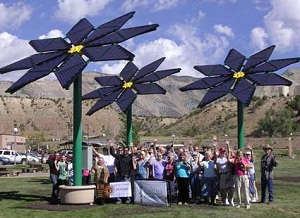Oil money helps pay for solar installations in Western Colorado
 On the western side of the Colorado Rockies, there is a community of several small cities and towns joined by two rivers. They’re now also joined together in an effort to generate their own power.
On the western side of the Colorado Rockies, there is a community of several small cities and towns joined by two rivers. They’re now also joined together in an effort to generate their own power.
This week, the final photovoltaic solar project in Garfield County will break ground, and when it’s finished, every town from Parachute to Carbondale will have solar power on the roof of at least one prominent government building.
The projects in all five towns are completely paid for, which means that as soon as the switches are flipped, they will be generating completely free energy, said Heather McGreggor, spokeswoman for Clean Energy Economy for the Region, or CLEER.
Much of the money for the projects comes from a state grant made possible by the Energy Impact Fund, money collected from energy companies drilling for oil and natural gas and mining coal and oil shale in Colorado.
The Western Slope of Colorado has long been at the mercy of major energy companies like Shell and Encanna, who have significant stakes in the land around Garfield County.
It’s one of the country’s largest natural gas drilling sites and one of the most well-known sites for oil shale.
“It’s great to see some of that money being cycled back into the community,” McGreggor said.
The Glenwood Springs Community Center turned on its new solar array in November and began generating power.
The Garfield County Fair Grounds riding arena in Rifle will be home to the largest solar array in the county’s CLEER project when it’s finished later this year, McGreggor said. The 101-kilowatt sstem will generate about 57 percent of the facilities needs.
“Our goal was to have solar or something like it on the roof of a building in every community,” McGreggor said. “And we’ve accomplished that.”
The local governments in Rifle and New Castle were able to add some money to the projects, which allowed those two to grow beyond the size of the projects in the other communities, McGreggor said.
Most of the projects were also able to take advantage of rebates and incentives from Xcel Energy, the local utility provider. But Glenwood Springs provides its own power and couldn’t offer any extra incentives, which resulted in a smaller system there. However, producing 2 percent of the community center’s total need, for free, will result in some significant cost savings, McGreggor said.
“It’s just great, because it really is free power,” she said.
Image courtesy of CLEER.



